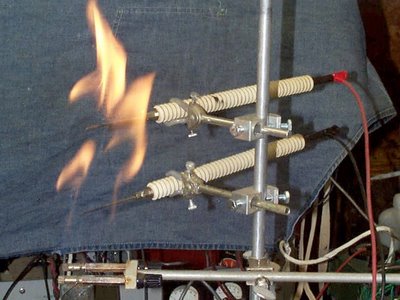Get one up on Johnny. Singe Johnny’s mullet with this super hot omni directional speaker.
The Application:
Its Johnny’s birthday beach party with a group of friends. You pull up with your girlfriend just as Johnny was scratching his head, staring at his new “Paris” CD his mom bought him for his birthday. You can read the indecisiveness on his face. His hand is bobbling the CD. Its just moments away from being popped into his Boombox. Sweat starts to trickle from your brow. Your girlfriend glances at Johnny and then back at you with a look of horror. “Do something!” she whispers. You have act before its too late. You quickly unload your portable campfire rig and propane tank that everyone has grown to love. Little does the group know, you’ve made an important modification. A modification that will save this beach party…
The G2:
Ion or “Flame” Speakers
Back in 1968, Popular Electronics published an article titled “MUSIC FROM THE FIREPLACE MAY BE AROUND THE CORNER” (see The Resource Pool). This article describes how to turn a flame into a high fidelity speaker that broadcasts sound in all directions . . . spherically through a full 360 degrees. The principle is that though an ionization process, two electrodes connected to an amp and a sound source will produce sound from a flame. As a result of this article, several new flame speaker products popped onto the market in the early seventies. Since then, various artists have incorporated this technology into performance art pieces. It is/was also on display in San Francisco’s Exploratorium.
An explanation of this effect can be found in the following excerpt from the article:
“Although the molecules in a gas do not normally "hang together" as in a liquid, highly ionized gas molecules do. And thus, in such special cases of high ionization, the ions in gas exhibit cohesion much as in a liquid. Being cohesive, the ions have substance enough to exhibit "surface tension"-again, just as do ions and molecules in a liquid. As such, gaseous ions form a kind of invisible diaphragm which might logically be expected to couple with and to exert force upon adjacent air molecules. If such were, in fact, the case, a modulated highly ionized electrical current in a combustion zone might "beat" against adjacent air molecules, converting its electrical energy to audio energy, much like the physical behavior of a loudspeaker's solid diaphragm on the air around it.”

The ion “plasma” is created by introducing ionizable elements into the flame such KNO3 and salts (see The Resource Pool). The hotter the flame, the more ionization takes place, the greater the conductivity, and the better the output.
The Tactics:
Create a flame speaker using a very reasonably-priced portable campfire rig (see The Resource Pool) as the flame source. Fabricate an adjustable electrode stand and ion source that can be inserted into the campfire flame. Use extended leads from your kick’n car amplifier to attach to the electrodes and let the party begin! Cool as beans.

The Resource Pool:
Reprint of Popular Electronics article
Yukon Legend propane campfire
Definition: kno3
Making KNO3 - be very carefule!!!!!
No comments:
Post a Comment